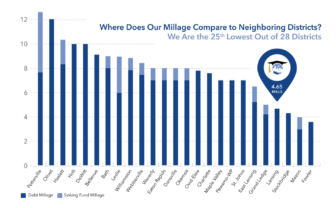On May 7, Lansing voters will see a millage question on their ballot. Called a “sinking fund,” the millage would provide the Lansing school district with funds to repair school buildings, which are, on average, 60 years old.

Maysa Sitar
This is how the millage compares to other towns in the area. Chart via the Lansing School District website.
Stephen Purchase is a concerned parent and president of the Parent Community Advisory Council . He volunteers his spare time toward helping the passage of this millage by providing information to community stakeholders.
“In my day job I help manage facilities and I know how important it is to maintain facilities so that they can have a long, useful life and serve the mission of educating our kids,” said Purchase. “If I can play a small role in helping folks see that and encouraging folks to support the school district, that’s what I want to do.”
Purchase said the sinking fund is one of the few ways schools can raise money for infrastructure repairs.
“It’s a property tax, it’s a millage, and those dollars are raised on an annual basis” said Purchase, “and they’re really for maintenance activities. If we want a nice community, we have to invest in it. All we can do is ask the community to support us.”
The millage would levy 3 mills for 10 years in the district, which includes parts of Ingham, Eaton and Clinton counties. A mill is $1 tax per $1,000 of your property assessment. This means that 3 mills would equate to $3 for every $1,000 in assessment. According to the Lansing School District website, the average assessment in the district is $42,000 and the owner of a home at this value would pay $126 per year for the millage.

Maysa Sitar
Lansing schools voter Elizabeth Hernandez
“We want to be able to see how that money is being utilized,” said Hernandez. “Not so much every detail, but at least being able to say, ‘this is how we’ve helped, this is what’s been done, this is what’s improving’.”
Jeff Scheibel, co-chair of the Sinking Fund Say Yes Committee, said the money would be distributed to all 26 schools based on a list of needs centering around safety and building repairs. Scheibel also encouraged everyone to seek more information about the millage.
“We’re not oblivious to the fact that there are going to be some people that are critical,” said Scheibel. “The only thing that I would hope is that if they do have questions, seek answers. Go to lansingschools.net,they’ve got the whole portfolio.”
Scheibel continued, “The students have been doing their job, the teachers have been doing their job, and now it’s our job as community leaders to do our job.”